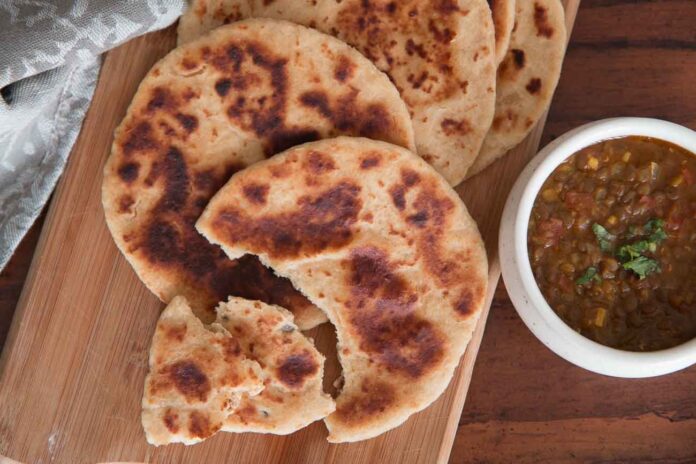Indian bread comes in various forms—leavened or unleavened, baked, fried, steamed or slapped across the cavernous walls of tandoor. To date, there are over 30 types of Indian bread and they differ from region to region, with each city putting their own spin on the type of flour used and cooking method applied. But what these bread generally have in common is their ability to mop up delicious curry sauces or house various types of toppings and stuffings.
It may be daunting to set out and explore the expansive world of Indian bread, so we’re here to help. Here’s a guide to seven popular Indian pieces of bread.
#Lucchi
Crisp, puffy and deeply fried in copious amounts of ghee or oil until golden, these greasy discs are among our favourite guilty pleasures. It is a common breakfast staple and snack served along with bhaji or some sort of curry throughout India.
One of the most common north-Indian food combos is puri-chholey. In Bengal, the puri takes on a softer, thinner version, called Lucchi. It’s paired with a simple potato curry or kosha mangsho (sauteed mutton). In winters, the Lucchi gets another avatar, the much-loved koraishutir kochuri.
#Malabar parotta
The Malabar parotta is a layered, flaky flatbread originating from the coastal Malabar region. It is similar to the north Indian lachchha paratha due to its crisp and flaky layers. The difference between the two is that the former is silkier and lighter as it is made with maida (processed flour). While kneading, water is replaced with egg and milk for a richer and softer output. Authentic Malabar parotta can be found in the streets of Kerala towns, and even in some parts of Tamil Nadu.
#Poi/Poee
Quite similar to pita pockets, the Portuguese-influenced poi is one of the most-loved bread in Goa. Brown, slightly husked and round, this chewy bread has a crusty outer layer and a hollow cavity that’s ideal for stuffing with delicious Goan foods (we love the chorizo sausage).
The leavened dough cakes take two minutes in a scorching hot oven to fluff and can be found in every local Goan bakery. The fluffiness of this bread makes it perfect for mopping up gravies and curry items. A combination that locals and tourists swear by is the coriander-laced chicken cafreal and poi.
#Appam
Native to God’s Own Country, Kerala’s appams are one of the tastiest flatbreads to come out of India. Made with rice flour, appam needs a little preparation beforehand. The batter is made with rice and coconut fermented overnight. The fermentation gives a dose of sour and sweet to the white, lacy pancakes. Crisp on one side and with an airy soft centre, appam is gluten-free and is often served along with a range of dishes like chicken or vegetable stews, egg curry, avial, korma, egg roast and kadala curry.
#Sheermal
This saffron-laced, sweet milk bread has Persian origins. It is made with ghee, flour, saffron and yeast, and is kneaded using milk (or sheer). The baking process happens in a loha (iron) tandoor which, quite often, is sprinkled with milk.
The result is the chewy, faintly aromatic and slightly sweet sheermal. It is amazing with kebabs and nihari, and also with a cup of tea. You will find sheermal in most Indian cities, but the best ones are found in Lucknow, Hyderabad, and Old Delhi and in many different versions, from nut encrusted to those filled with khoya.
#Pathiri
Although you’ll find it served across southern India, pathiri actually originated among the Mappila community of Kerala. This crepe-style unleavened flatbread is prepared with rice flour, oil, salt and water, and carefully kneaded to a smooth dough. The spotless white flatbread is light and paper-thin and is irresistible when served along with spicy chicken/mutton/beef or even fish curry.
#Bhakri
An important part of Maharashtrian cuisine, bhakri is made with flour from millets like jowar and sorghum, and ragi. Sometimes a bit of wheat or rice flour is mixed with it as well, making it high in dietary fibre. Ghee and cumin seeds are added to enhance the flavour.
The bread is traditionally served with a variety of chutneys, or with a side of baingan bharta (made with eggplants), or a curry of some sort. It is popular in states where millets are favoured due to local soils, geography and climate (e.g., Gujarat, Rajasthan, Maharashtra, and some parts of central India).


